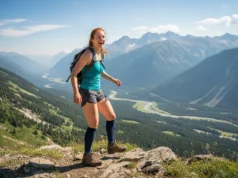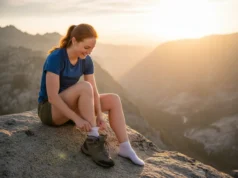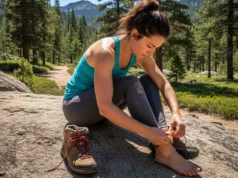In this article
For any hiker, understanding why are hiking socks important begins with recognizing that the most overlooked piece of gear is often the one making the most intimate and sustained contact with their body: the sock. We often treat a pair of socks as an afterthought, but for any hike, it is a critical interface between your foot and your footwear. To begin this guide, we must address the most foundational principle of performance fabrics. The axiom “cotton kills” is not hyperbole; it is a safety warning rooted in material science. The very properties that make cotton feel soft and absorbent in daily life become dangerous liabilities on the hiking trail. This guide will provide a comprehensive look at what are hiking socks and how to understand, select, and care for them to elevate your hiking craft.
Deconstructing the “Cotton Kills” Axiom
The primary failure of cotton is its hydrophilic nature, meaning it has a strong affinity for water. It readily absorbs moisture from sweat or rain, holding it directly against the skin instead of moving it away. A cotton sock can absorb up to 27 times its own weight in water, creating a saturated, cold layer around your foot. This isn’t just a catchy phrase; it is a succinct and serious safety warning that every outdoor enthusiast should understand.
When the fibers in cotton socks become saturated, their structure collapses, eliminating the microscopic air pockets that provide insulation. Water conducts heat away from the body 25 times faster than air, which is why a wet sock made of cotton leads to a dangerous and persistent chilling effect. This is a stark contrast to performance fabrics. Merino wool and synthetics are designed to actively transport moisture away from the skin. Synthetics are hydrophobic (they repel water), while merino wool has a complex structure that pulls moisture vapor from the skin. Understanding this material science is one of the fundamental principles of responsible hiking.
The on-trail dangers stemming from this failure are real. The most common issue is blisters, as moisture softens the skin and increases friction. Far more serious is the life-threatening risk of hypothermia, which can occur even on seemingly mild days if you get wet. In prolonged wet and cold exposure on the trail, this can lead to severe conditions like trench foot.
The Performance Trifecta of a True Hiking Sock
What separates a high-performance hiking sock from everyday cotton socks or even athletic socks? It’s how specific features work together to protect your feet. A good pair of socks will manage moisture, regulate temperature, and provide cushioning with some arch support, which is how the right socks prevent blisters and keep you comfortable on your hikes. These capabilities are what define a purpose-built hiking sock, setting it apart from any other sock in your drawer.
Moisture Management
This is the primary and most vital function. The ability of a sock to wick sweat away from the skin is the foundation for preventing blisters, managing foot temperature, and avoiding the clammy feeling of a wet foot. A sock’s core job is wicking sweat away from the skin, which is the first step toward maintaining foot health over long miles. Without effective moisture management, the other two functions are compromised.
Thermoregulation
Thermoregulation is the sock’s ability to help regulate your foot’s temperature across a wide range of conditions and terrain. The goal is to keep your feet feeling cool and breathable in the heat while remaining warm and insulated in the cold, providing enough warmth for any trek. Premium materials like merino wool excel at this, providing insulation even when damp. This is a critical performance advantage that ordinary socks cannot offer, making a quality sock an all-season tool.
Cushioning & Friction Mitigation
Cushioning is more than just soft padding for comfort; it’s a crucial mechanical buffer between your actual foot and the rigid interior of a boot. This padding absorbs impact with each step, reduces pressure on high-wear areas like the heel and the ball of the foot, and mitigates the shearing forces that cause hot spots and blisters. The level of cushioning also directly contributes to the sock’s overall warmth and the volume it takes up inside your shoes.
The Anatomy of a High-Performance Hiking Sock: Materials & Construction
A deep dive into the two core components of a hiking sock—the material it’s made from and its physical construction—is essential. Understanding these technical features will empower you to read sock packaging, understand product specifications, and make an informed choice for your next trip to the outdoors.
Merino Wool: Nature’s Premier Performance Fiber
When it comes to merino wool socks, this is the most popular and highly recommended material for hiking socks, and for good reason. Sourced from Merino sheep, this natural fiber has been refined to be exceptionally fine and soft, completely debunking the old stereotype of “itchy wool.” This isn’t the scratchy ragg wool socks of the past. Its core properties are superior moisture management, excellent thermoregulation, and natural antimicrobial odor resistance.
The science behind its performance lies in the fiber’s natural “crimp,” a wave-like structure that creates thousands of tiny air pockets. These pockets trap air for insulation and help the fiber retain its lofty, insulating structure even when damp. The science behind moisture-wicking wool reveals a complex fiber with a water-absorbing inner core and a water-repelling outer layer. This allows it to absorb moisture vapor—up to 30% of its weight—before it even feels wet, actively maintaining a dry microclimate against the skin.
Base Layer Fabric Comparison
Choose the right material for your layering system.
Merino Wool
The natural, all-around champion for performance in a wide range of conditions.
Synthetics
The workhorse for high-output activities where sweat and durability are key factors.
Cotton
“Cotton Kills.” Avoid for any technical hiking due to its poor performance when wet.
The Synthetic Arsenal: Polyester, Nylon, and Spandex
Synthetic fibers are the durable workhorses of sock construction, often blended as wool and/or nylon to provide structure, durability, and rapid moisture transport. Their key advantage is that they are hydrophobic, meaning they don’t absorb water. This property makes them exceptionally fast-drying, a critical performance metric for hikes in wet conditions or on tough terrain.
Each synthetic plays a specific role. Nylon is prized for its exceptional durability and abrasion resistance, making it a key ingredient for a tough sock. Polyester is an effective moisture-wicker and insulator, with branded versions like COOLMAX® engineered for enhanced moisture transport. Finally, Spandex, often branded as Lycra®, is an elastic fiber added in small amounts. It provides the stretch and recovery that allows a sock to hold its shape, stay up on your legs, and prevent the bunching that leads to blisters. The main drawback of synthetics is their tendency to harbor odor-causing bacteria.
The Cushioning Spectrum and Height Hierarchy
Cushioning refers to the sock’s thickness, created by knitting terry loops of yarn into the fabric. It serves a dual purpose: providing impact absorption and adding extra warmth. The common levels are Zero Cushion (ultralight socks) for hot weather, Light Cushion for versatile day hikes, Medium Cushion for backpacking, and Heavy Cushion for mountaineering or extreme cold. It can be a personal preference, leading to a healthy sock cushioning debate among hikers.
A cardinal rule for blister prevention is that your sock height must always be taller than the cuff of your footwear. This non-negotiable principle is because high socks protect against abrasion that big, burly boots can cause around your shins and calves. Sock heights are standardized to match different footwear. No-show socks and Ankle/Quarter heights work for low-profile hiking shoes or trail runners, while classic crew socks are the standard for most hiking boots. The popular hiker micro crew or micro crew socks height has become a modern standard that sits just above a standard boot cuff, protecting the ankle bones.
| Cushion Level | Primary Use | Feel & Volume | Best For |
|---|---|---|---|
| Zero Cushion | Hot weather, trail running | Ultralight, maximum feel | Maximum breathability, minimal bulk |
| Light Cushion | Day hiking, 3-season use | Light padding underfoot | Versatility and comfort |
| Medium Cushion | Backpacking, long-distance | Substantial padding, more volume | Heavy packs, added protection |
| Heavy Cushion | Mountaineering, winter | Thickest padding, most warmth | Extreme cold, stiff boots |
The Strategic Selection Process: Choosing the Right Sock for Your Hike
Translating technical knowledge into a practical decision-making framework is the next step. A footwear specialist can help, but this guide will empower you to select the perfect sock by considering the demands of your hike, the climate, your footwear, and the critical goal of blister prevention.
Matching Socks to Your Hike, Climate, and Footwear
The type of hike dictates the level of protection you need. For most day hikes or a short nature walk, a lightweight hiking sock with light cushion offers a great balance of comfort and breathability. For a multi-day backpacking trip with a heavy pack, stepping up to a medium cushion sock provides superior shock absorption. For mountaineering in the mountains, a heavyweight cushion sock is necessary inside stiff boots. Thinking through these factors is how to pick the right hiking socks for you.
Climate is another major factor. For summer hiking in hot weather, prioritize breathability with lightweight hiking socks made from synthetics or light merino blends. For winter hiking or cold-weather backpacking trips, insulation is paramount, making mid- to heavyweight wool socks the best choice for their merino wool warmth. For footwear, the rule is simple: socks must be taller than the boot cuff. For trail running shoes and low cut shoes, you can use no-show or quarter heights. For traditional mid- and high-cut hiking boots, crew or boot-height socks are mandatory to protect your shin and ankle.
A Comprehensive Guide to Blister Prevention
Blisters are caused by the “Blister Triangle” of friction, moisture, and heat. While friction does the damage, moisture is the great amplifier, softening the skin around your toes and heel. Your sock is the first line of defense. This means choosing moisture-wicking materials, ensuring a proper sock fits your foot size correctly—not just your shoe size—and carrying a spare pair of socks. Preventing blisters is about systematically managing the forces at play on the foot.
The sock liners debate continues. The traditional argument is that a thin liner sock wicks moisture and moves friction between fabric layers. The modern view is that advanced single-sock technology often makes liner socks unnecessary. It remains a personal choice, but a single-sock system is often superior. Finally, the absolute foundation of prevention is a pair of properly fitted and broken-in boots. Always proactively tape known hot spots before you start hiking and, most critically, stop immediately to address any discomfort.
| Prevention Tactic | Why It Works | Key Action |
|---|---|---|
| Proper Sock Material | Wicks moisture away from skin | Choose Merino Wool or Synthetics. No cotton. |
| Correct Sock Fit | Prevents bunching and constriction | Ensure a snug fit with no wrinkles; get correct size socks. |
| Proper Boot Fit | Eliminates primary source of friction | Get professionally fitted; break in boots thoroughly. |
| Carry a Spare Pair | Keeps feet dry | Swap to dry socks mid-hike or at camp. |
| Address Hot Spots | Prevents blisters from forming | Stop immediately and apply tape (e.g., Leukotape). |
The Brand Landscape and Conscientious Choice
Now that you understand the science and strategy, let’s look at the market. We’ll analyze the major players in the hiking sock world, including specialty brands for the dedicated thru hiker, and delve into the important factors of sustainability and ethics.
The Market Leaders: Darn Tough vs. Smartwool Showdown
The Darn Tough vs Smartwool hiking socks comparison is the most common deliberation for regular hikers. Both make premium merino wool products in the USA, but they have distinct philosophies. The choice is less about which is “better” and more about which is a better fit for your priorities and annual sock budget.
Darn Tough is known for legendary durability and an unconditional lifetime guarantee. This is achieved through a high-density knit and a higher nylon content, which results in a snugger, performance-oriented fit. They are ideal for hikers who prioritize longevity and minimal sock slippage. Smartwool, on the other hand, is characterized by its exceptional out-of-the-box comfort and plush feel. This comes from a higher merino wool content, making them an excellent choice for those who prioritize immediate softness. Other key players include REI Co-op, which offers great value, and Bridgedale, a UK brand known for its hard-wearing blends.
| Brand | Known For | Fit Profile | Key Feature |
|---|---|---|---|
| Darn Tough | Unmatched Durability | Snug, performance fit | Unconditional Lifetime Guarantee |
| Smartwool | Out-of-the-Box Comfort | Wider, plusher fit | High merino wool content for softness |
| REI Co-op | Excellent Value | Standard fit | Good performance at a lower price point |
| Bridgedale | Durability & Drying Speed | Technical fit | “Fusion Tech” wool/synthetic blends |
Specialty Socks and Sustainable Choices
Beyond the mainstream brands, there are specialty brands that solve niche problems. Injinji’s five-toe sock design completely eliminates skin-on-skin friction between the toes, making it a powerful solution for inter-digital blisters. Waterproof socks from brands like Sealskinz are a specialized tool for relentlessly wet conditions. They can have limited breathability, but sometimes “warm and wet” is a better outcome than “cold and wet.”
Sustainability and ethics are also important considerations. The Responsible Wool Standard (RWS) is a crucial certification ensuring the humane treatment of sheep; major brands like Smartwool and Darn Tough use RWS wool. On the synthetic side, brands are mitigating the environmental footprint by using recycled materials like REPREVE® nylon and COOLMAX® EcoMade polyester. Some brands, like Smartwool with their “Second Cut™” program, are even creating circular economies for old clothing like socks and jackets.
Ownership and Care: Maximizing the Lifespan of Your Investment
Proper care is essential to protect the investment you’ve made in technical socks. Following these guidelines will preserve the performance properties of the fibers, extend the life of your socks, and ultimately save you money. One of the best features of merino wool is its natural odor resistance, which means it can be worn multiple times between washes on long trips.
The Right Way to Wash and Dry Your Hiking Socks
To properly wash your socks, the first and most critical step is to turn them inside out. This allows the water and detergent to wash away skin cells and sweat more effectively while protecting the outer face from pilling. Use a gentle cycle with cool or lukewarm water and a mild detergent. What should you avoid? Never use bleach, which destroys wool fibers, or fabric softener, which ruins their wicking properties. For specific guidance, many brands offer detailed instructions, such as this guide on how to wash merino wool socks.
The best way to dry your socks is to air dry them by laying them flat or hanging them outside away from direct heat. If you must use a machine, insist on the lowest heat setting or a no-heat tumble dry cycle. High heat is the primary enemy of both wool and the spandex that gives your socks their shape and fit. A few extra minutes of air-drying time is a small price to pay to protect the investment in technical socks.
Conclusion: Your First Step Towards Happier Feet
Selecting a hiking sock is a technical decision, not an afterthought. It has a profound impact on your comfort and safety in the great outdoors. By understanding the core selection framework and how to match the sock to your specific hike, climate, and footwear—whether it’s sturdy boots or light hiking shoes—you can move from being a passive buyer to an informed analyst. You are now equipped to build a versatile quiver of socks. Moving beyond cotton is the first step, but true mastery lies in applying this strategic approach to ensure your feet are supported, making them happier feet. The right pair of socks is a cornerstone of your hiking system, far more than just another item in your sock drawer.
Frequently Asked Questions about Hiking Socks
What is the single best all-around hiking sock for a beginner? +
How many pairs of hiking socks should I bring for a multi-day backpacking trip? +
Are sock liners still necessary with modern hiking socks? +
Can I wear two pairs of regular socks instead of one pair of thick hiking socks for warmth? +
We are a participant in the Amazon Services LLC Associates Program, an affiliate advertising program designed to provide a means for sites to earn advertising fees by advertising and linking to Amazon.com. As an Amazon Associate I earn from qualifying purchases. We also participate in other affiliate programs. The information provided on this website is provided for entertainment purposes only. We make no representations or warranties of any kind, expressed or implied, about the completeness, accuracy, adequacy, legality, usefulness, reliability, suitability, or availability of the information, or about anything else. Any reliance you place on the information is therefore strictly at your own risk. Additional terms are found in the terms of service.





